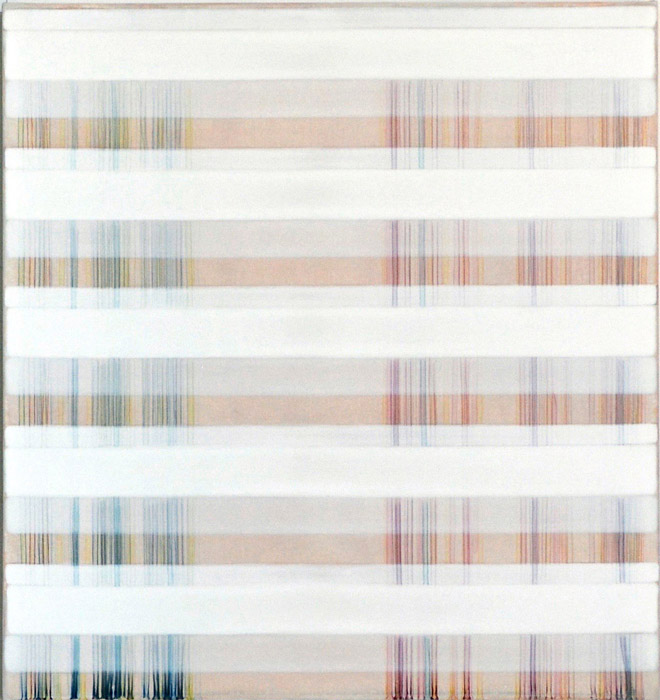
A solo exhibition of new work, “SEEP line,” by Johnnie Winona Ross will open at Charlotte Jackson Fine Art on September 1 and extend through October 1. An Opening Reception with the artist will be held on Friday, September 1 from 5-7 p.m. There will be a Gallery Talk, with Johnnie Winona Ross in dialogue with Publisher of Radius Books, David Chickey, on Saturday, September 2 from 3 p.m. to 4 p.m., followed by a book signing of Johnnie Winona Ross published by Radius books. The gallery is located in the Railyard Arts District at 554 South Guadalupe Street.
A profound quiet. Runnels of color surface and descend through woven white. This is not the silence that is secession of sound but the quiet of the world waiting, of a still point of time and experience gathering toward fruition. The silence that radiates from these paintings is the silence of the desert – striated canyons, floating mesas, moon on sand, light glinting on precious water. But it is also the same quiet as a cathedral, a wall of petroglyphs, an ancient Greek sculpture, the silence between the notes of jazz masterpiece. The silence of art.
As the title of the exhibition, “SEEP line,” suggests, Johnnie Winona Ross’ paintings are landscapes – though not in a way that is immediately recognizable. Each of Ross’ paintings is inspired by a particular place, often close to his mesa home near Taos, New Mexico. With a spare visual language, Ross creates works which invoke the small, secret presence of water in the desert – places where water seeps out through canyon wall and mesa edges, up from underground springs. In the vast dry spaces of the arid southwest, seeps are special places where one can find signs of thriving life: hanging gardens, animal tracks, even the ancient marks of civilizations past who may have used the same seep for hundreds of years.
Ross came of age as an artist in a time when Abstract Expressionism was fading and Pop and Minimalism were taking hold. At Washington University in St. Louis, where he studied art, the professors ranged from AbEx and former Bauhaus painters to Minimalists. There were those whose influences were more “traditional” (Monet, Cezanne) and those whose direct lineage came from Albers or Arnheim. In this rich atmosphere of artistic and cultural change, Ross found his own way, citing an eclectic mix of influences, including Donald Judd, William De Kooning, Pierre Bonnard, Eva Hesse, and the Anasazi/Barrier Canyon Native American artists. Two artist residencies in Roswell, New Mexico further impacted the direction of his work, as well as prompting him, in 1999 to leave his post at the prestigious Maine College of Art and move to New Mexico to set up a studio.
Note is often made of Ross’ “grid” pattern. Though the “grid” is present with Ross’ work in principle, it feels like a misleading analogy. Rather, Ross’ influence seems more natural – the process of water and mineral dripping through ground. The effects of water on stone and earth, the colored striations, mineral and salt deposits, all of these can be seen, not only in Ross’ canvases, but in his process. For Ross, the “ground” is white. Horizontal bands of gypsum, titanium, or zinc whites sweep across the canvas. The bars are structured, measured, changing in density from center to edge and back, creating a flow or focus toward the center. These white bars establish the geological matrix upon which Ross’ colored lines flow, vertically, freeform, down the canvas. The colored lines are created with water and mineral or burnt-bone pigments. Though the lines can seem almost uniform or planned – they are in fact drips, allowed to flow and move under and through the tonal bands of white. Once dry, this first layer of whites and color are burnished with a pueblo potter’s stone. Then the process begins again. As many as 100 to 200 layers of paint are applied, usually burnished between every layer. Ross’ paintings, like the slow ancient seeps that create vertical “paintings” across canyon walls, take years to create. In fact, paintings included in “SEEP line” have dates ranging from 4 to 8 years from start to completion.
This process of time, building up the painting, burnishing it smooth, can all be seen in the sheen of the canvases and the depth of color. Each line– an aqua blue, a spring green, a burnt orange, is marked with the layers of what came before. Many of the lines read more like channels – with deeper color at the edges – the effect of minerals deposited and building up over time as the paint “seeps” occur again and again. Time itself is recorded on these paintings which seem like some fantastic balance between natural and human forces at work. The very physicality of the canvases, with their artisan basswood stretchers, textured linen, and hand-made copper tacks, supports the intense felt-presence of these works.
But beyond the history and process that can be read on these canvases, there comes that quiet, the rhythmic breath that seems to emerge from within them. The finished effect of Ross’ work is almost elemental, suggesting some basic and essential interaction between humans and nature. As Ross has said, “Ultimately, I try to create the experience of sanctuary that is apart from the chaos and uncertainties of the world.” With their gentle color traces, eddied and precipitated into nuanced lines, with their breathing white ground, these paintings do create a sanctuary – like water in the desert.

